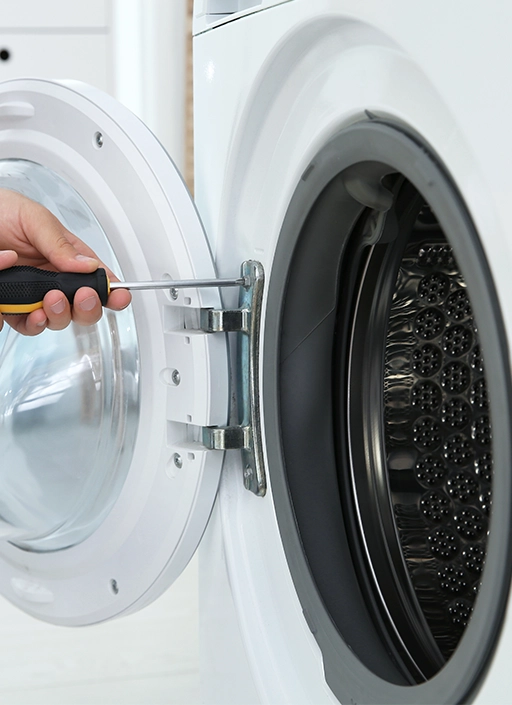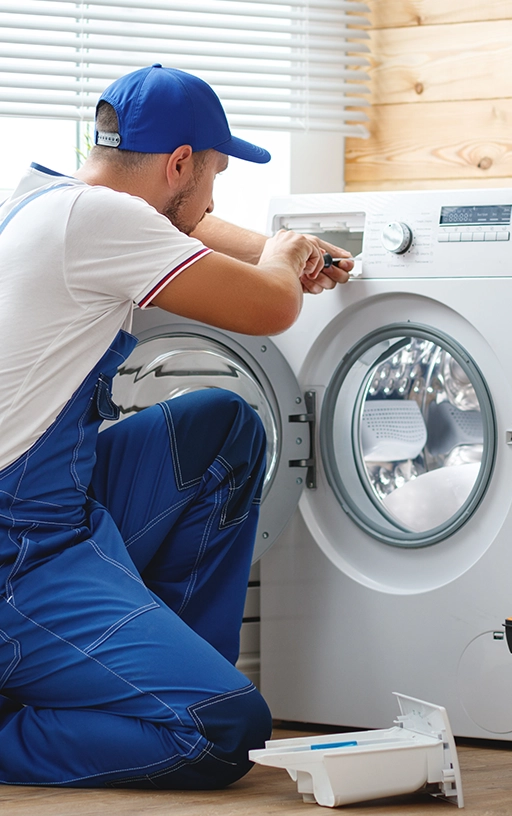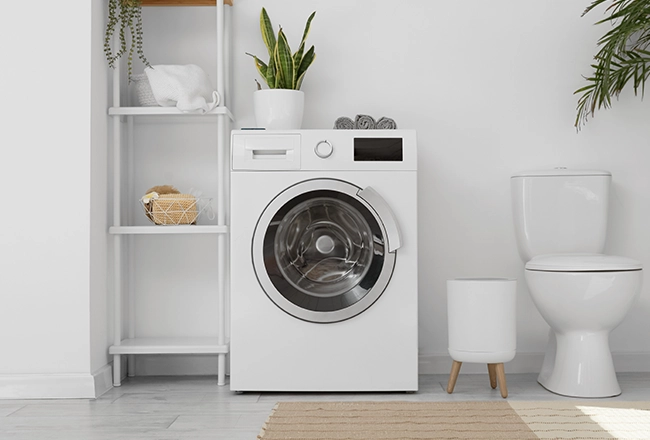Competitive Pricing
Professional Service
6-Month Warranty
Same-Day Repairs

Dryer Repair Technicians in Toronto
In Canada, the average household does 400 loads of laundry per year. Half of this process is often placing your wet clothes in the dryer. Having access to a washer and dryer at home is a must for many households. Especially for large families, the time that a washer and dryer can save is simply invaluable. The ability to wash and dry clothes on demand saves you multiple trips to a laundromat each week. Contact us for dryer repair technicians in Toronto.
While drying racks and hanging contraptions are both eco-friendly and cost-efficient, they take up a great deal of space. This makes them difficult to incorporate into smaller settings such as studio apartments, dorm rooms, tiny houses, and co-living spaces. As well, they are not very useful for outdoor air-drying in the winter, as clothes can freeze instead of dry. For many, it simply isn’t feasible to be able to hang all of their clothes in their home for an undetermined amount of time — since it can take several hours for clothes to fully air-dry. In these cases, having instant access to a dryer can be a huge benefit.
Benefits of Using a Dryer
Not only does a home dryer save you time by being able to dry clean clothes in as little as 20 minutes, but it often saves you significant dollars throughout its lifetime, when compared to going to a laundromat (as laundromats and paid dryers can add up). When implementing cost-cutting and energy-efficient methods such as cold washes and low-heat drying cycles, you can significantly reduce the environmental impact and overall cost of operating your washer and dryer. Thus, making it a prudent financial option for many households.


Dryer Repair Services
For all of these reasons, washing machines and dryers are a matching pair in countless homes across Canada. Unfortunately, it can be a significant blow to your routine when your dryer fails to operate correctly. At Prime Appliance Repairs, our team of dryer technicians offers years of experience solving all kinds of issues with dryers. Whether your dryer won’t heat up, tumble, or start, we can help. We pride ourselves on our ability to identify the issue and solve it with minimal interruption to your daily routine. Once the issue is identified, our technician provides a comprehensive quote with a transparent price, so you know exactly how much you are paying for your repair.
Our technicians are fully trained on how to diagnose issues and repair a variety of dryers, including front-load & top-load models, vented systems, condensing and heat-pump designs, and washer-dryer combos. If you do not see your make or model in our list of dryer providers, please contact us directly to inquire about a repair.
We provide comprehensive diagnostic and repair services for a wide variety of common dryer issues, including:
- Broken fuses
- Temperature switches
- Thermostats
- Heating coils
- Belts
- Rollers
- Timers
- Faulty tumble setting
- Too much or too little heat
- Clogged and broken vents
Our dryer technicians have years of experience working with these appliances, so you can trust that they can repair your appliance efficiently and professionally. In the event that a repair would be more expensive than a replacement, our technicians can also recommend suitable replacement models for your situation. If your dryer is experiencing any other issues not listed above, contact us directly for a solution and a quote.
When it comes to dryer repairs, we try to minimize disruptions to your routine as much as possible. In some cases, we can offer same-day diagnosis and repairs for common dryer problems. If the issues persist, it may take longer to repair. For every project, they will communicate accurate timelines and pricing quotes before starting any repairs.
Our technicians provide a full quote on-site after performing a diagnostic test to identify the issue. We pride ourselves in offering transparent pricing, so you never receive an unexpected bill for our services.
Our service call is $99 plus HST. From there, you are only responsible for paying for any necessary parts and labour. You will receive a quote before any work takes place, ensuring you know exactly what you’re paying before work begins.
Dryer Repair FAQs
When your dryer won’t start, the technician will inspect several parts until he finds the cause. These include:
Thermal Fuse
The thermal fuse is a safety device designed to protect the dryer from overheating. The fuse should be closed for continuity meaning it has a continuous electrical path through it when good. If overheated, the fuse will have no continuity meaning the electrical path is broken and the fuse has blown.
Start Switch
If the start switch is defective, the dryer won’t start and it would have to be replaced.
Door Switch
The door switch activates when the dryer door is closed. On most dryers, the door switch makes an audible clicking sound when it activates.
Drive Motor
The drive motor turns the drum and the blower wheel to exhaust the air.
Belt Switch or Drive Belt
On most dryers, when the dryer belt breaks, the motor will still run, but the drum won’t turn. However, some dryers have a switch that shuts off power to the dryer if the drive belt is broken. If this switch fails, it could shut off power to the dryer even when the belt is not broken.
Incoming Power Problem
If you have a gas dryer, unplug the dryer from the wall and plug something else into the outlet to determine if the outlet is working. If you have an electric dryer, check the home circuit breaker or fuses. If the circuit breaker or fuses are working, use a multimeter to test the outlet.
Main Control Board
The main control board might be defective. However, this is rarely the case.
Timer
The timer might be defective. However, this is rarely the case.
The parts that a technician will inspect in the dryer to determine which needs to be fixed are:
Drive Belt
The drive belt is a very long, slender belt that wraps all the way around the dryer drum, around a tension pulley, and then around the drive motor pulley. Over time, the belt can break from normal use. If the belt is broken, the dryer won’t turn.
Drum Roller
One or more of the drum rollers might be worn out. Most dryers have two drum support rollers on the rear of the drum, and some dryers have two more rollers supporting the front of the drum. The rollers must spin freely to work properly. If the rollers don’t spin freely, the motor will get overloaded and the dryer will stop. If the drum rollers are worn out, the rollers may not spin freely.
Drum Support Roller & Axle
Oe or more of the drum roller axles might be worn out. Most dryers have two drum support rollers on the rear of the drum, and some dryers have two more rollers supporting the front of the drum. The rollers must spin freely to work properly. If the drum roller axles are worn out, the rollers may not spin freely, causing the motor to overload and the dryer to stop.
Drum Slide, Glide, or Pad
If the dryer stops turning during the cycle, one or more of the drum glides (also called slides) might be worn out. The drum glides are small plastic pieces that support the front of the dryer drum. As the drum rotates, it slides on these plastic pieces. Over time, the drum glides wear out. If the drum glides are worn out, the drum can start binding and put strain on the motor. If this happens, the motor shuts down, preventing the dryer from turning.
Drum Bearing
The drum bearing supports the rear of the dryer drum. Over time, this bearing wears out. If the drum bearing is worn out, it might put too much strain on the motor, causing the dryer to stop mid-cycle.
Drum Roller Axle
One or more of the drum roller axles might be worn out. Most dryers have two drum support rollers on the rear of the drum, and some dryers have two more rollers supporting the front of the drum. The rollers must spin freely to work properly. If the roller axles are worn out, the rollers may not spin freely, causing the motor to overload and the dryer to stop.
Drive Motor
The drive motor turns the drum and the blower wheel to exhaust the air. If the dryer runs, stops for a while, and then starts again, this likely indicates that the motor is overheating, causing the dryer to shut off until the motor cools down.
Drum Support Bearing
The drum bearing supports the rear of the dryer drum. Over time, this bearing wears out. If the drum bearing is worn out, it might put too much strain on the motor, causing the dryer to stop mid-cycle.
Dryness Control Board
The dryness control board shuts off the dryer when the clothes have reached the proper level of dryness. If the control board is defective, it may cause the dryer to stop too early. However, this is rarely the case.
Possible parts that may need replacement in the dryer to repair this issue include:
Drive Belt
The drive belt is a very long, slender belt that wraps all the way around the dryer drum, around a tension pulley, and then around the drive motor pulley. Over time, the belt can break from normal use. If the belt is broken, the dryer won’t turn.
Drum Roller
Most dryers have two drum rollers on the rear of the drum, and some dryers have two more rollers supporting the front of the drum. The rollers must spin freely to work properly. If the drum rollers are worn out, the dryer won’t turn properly.
Drum Roller Axle
Most dryers have two drum support rollers on the rear of the drum, and some dryers have two more rollers supporting the front of the drum. The rollers must spin freely to work properly. Over time, the drum roller axles can wear out, causing the rollers to bind. If the rollers are worn out or start binding, the motor will get overloaded and the dryer won’t turn.
Drum Bearing
The drum bearing supports the rear of the dryer drum. Over time, this bearing wears out. If the drum bearing is worn out, the dryer may not turn properly.
Nobody wants to wait for hours for their clothes to dry, and the dryer is supposed to dry the clothes within the timeframe of the cycle. Luckily, it is an easy problem to solve by a correct inspection and possible replacement of a part. Take a look at some part that may cause the drying time to be too long:
Air Flow Problem
If the vent is clogged or partially clogged, it will restrict the airflow through the dryer, substantially increasing the drying time. To ensure proper dryer performance, you should clean your dryer’s venting system at least once per year.
Blower Wheel
Clumps of lint, socks, and small articles of clothing can escape the lint filter and get caught in the blower wheel. In addition, the blower wheel sleeve can wear out, allowing the blower wheel to wobble on the motor shaft. If the blower wheel is obstructed or defective, it may take too long to dry clothes.
Heating Element
The heating element warms the air before the air enters the dryer drum. If the heating element is defective, the dryer may not heat.
Lint Filter
The lint filter might be clogged, reducing the air flow.
Moisture Sensor
If the moisture sensor is malfunctioning, it could inaccurately report that the clothing is still moist, causing the dryer to keep running even though the clothes are dry.
It is a serious danger when a dryer overheats. For your own safety, you should stop using it immediately and call a technician to perform a diagnosis and to repair it. Possible causes for this issue are:
Heating Element
The heating element warms the air before the air enters the dryer drum. When malfunctioning, it may produce heat continuously, even if the dryer has reached the proper temperature. When this happens, the dryer gets too hot.
Air Flow Problem
If the vent is clogged or partially clogged, it will restrict the airflow through the dryer, substantially increasing the drying time.
Cycling Thermostat
The cycling thermostat cycles the heat on and off to maintain the proper air temperature. If the thermostat is defective, it may keep the heat on too long, causing the dryer to get too hot.
Blower Wheel
If the blower wheel is obstructed with lint and small articles or is defective, the dryer may get too hot.
Do you have a wobbly or squeaky noise coming from your dryer as it works? Possible causes to this problem are:
Drive Belt
Over time, the drive belt can become frayed or otherwise damaged. If the drive belt is frayed or damaged, the dryer will be noisy as it turns.
Drum Roller
One or more of the drum rollers might be worn out. When the drum rollers are worn out, they can cause the dryer to make a loud rumbling noise.
Blower Wheel
The blower wheel draws air through the dryer and pushes the air out the vent. Clumps of lint, socks, and small articles of clothing can escape the lint filter and get caught in the blower wheel. If an object is caught in the blower wheel, the dryer may make noise. In addition, the blower wheel sleeve can wear out, allowing the blower wheel to wobble on the motor shaft.
Drum Bearing
The drum bearing supports the rear of the dryer drum. Over time, the drum bearing wears out. If the drum bearing is worn out, the dryer may make noise.
Drum Glides
Over time, the drum glides wear out. If the drum glides are worn out, the dryer will make noise.
If your dryer won’t stop, a few parts need to be inspected, such as:
Blower Wheel
If the blower wheel is obstructed with lint and small articles or is defective, the dryer may get too hot.
Heating Element
The heating element warms the air before the air enters the dryer drum. Over time, the heating element can burn out. If the heating element isn’t working, the clothes will take substantially longer to dry.
Lint Filter
The lint filter might be clogged. Dryer sheets and fabric softener can leave a residue on the lint filter, reducing the air flow. If the lint filter is clogged, clean it.
Moisture Sensor
If the moisture sensor is malfunctioning, it could inaccurately report that the clothing is still moist, causing the dryer to keep running even though the clothes are dry.









